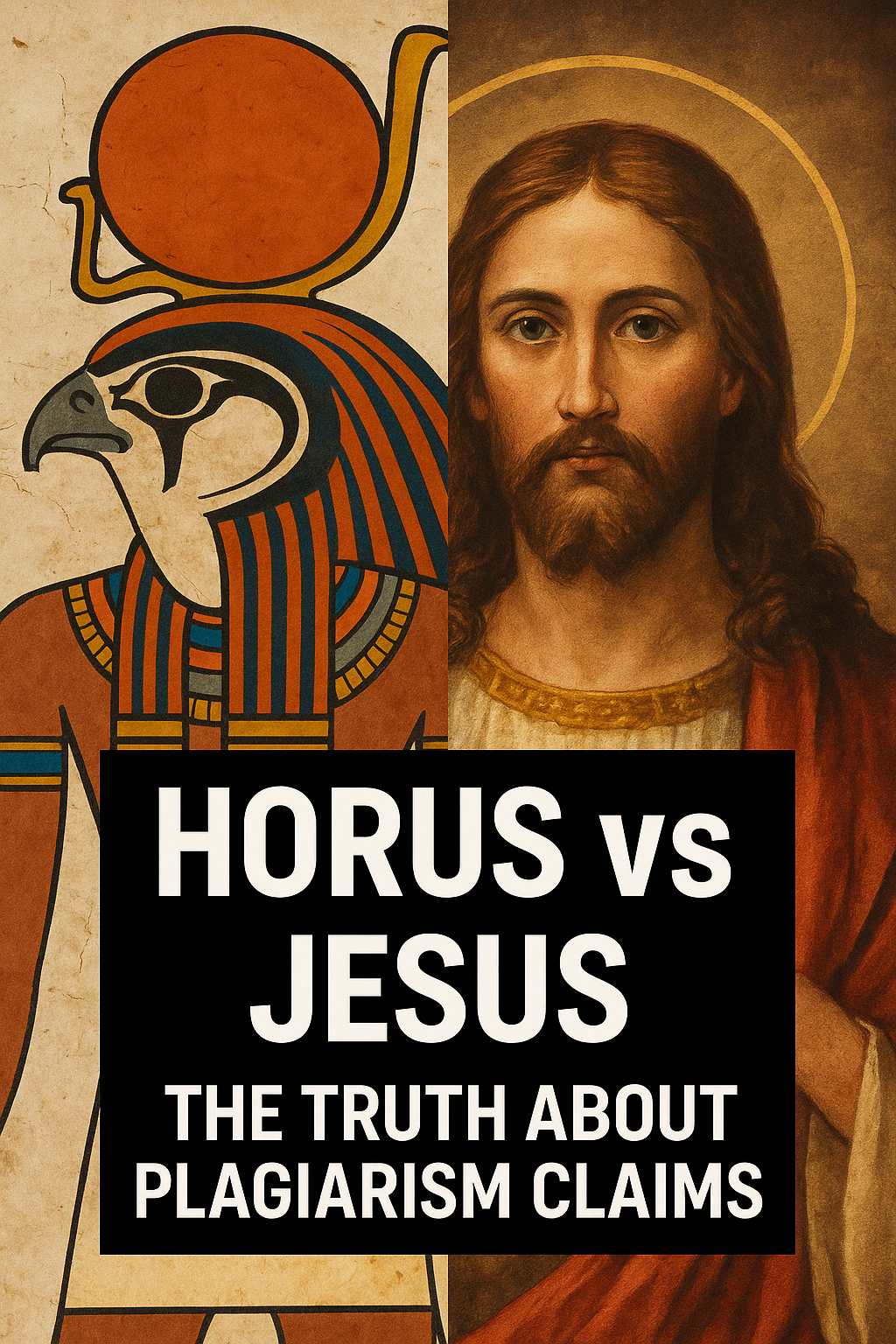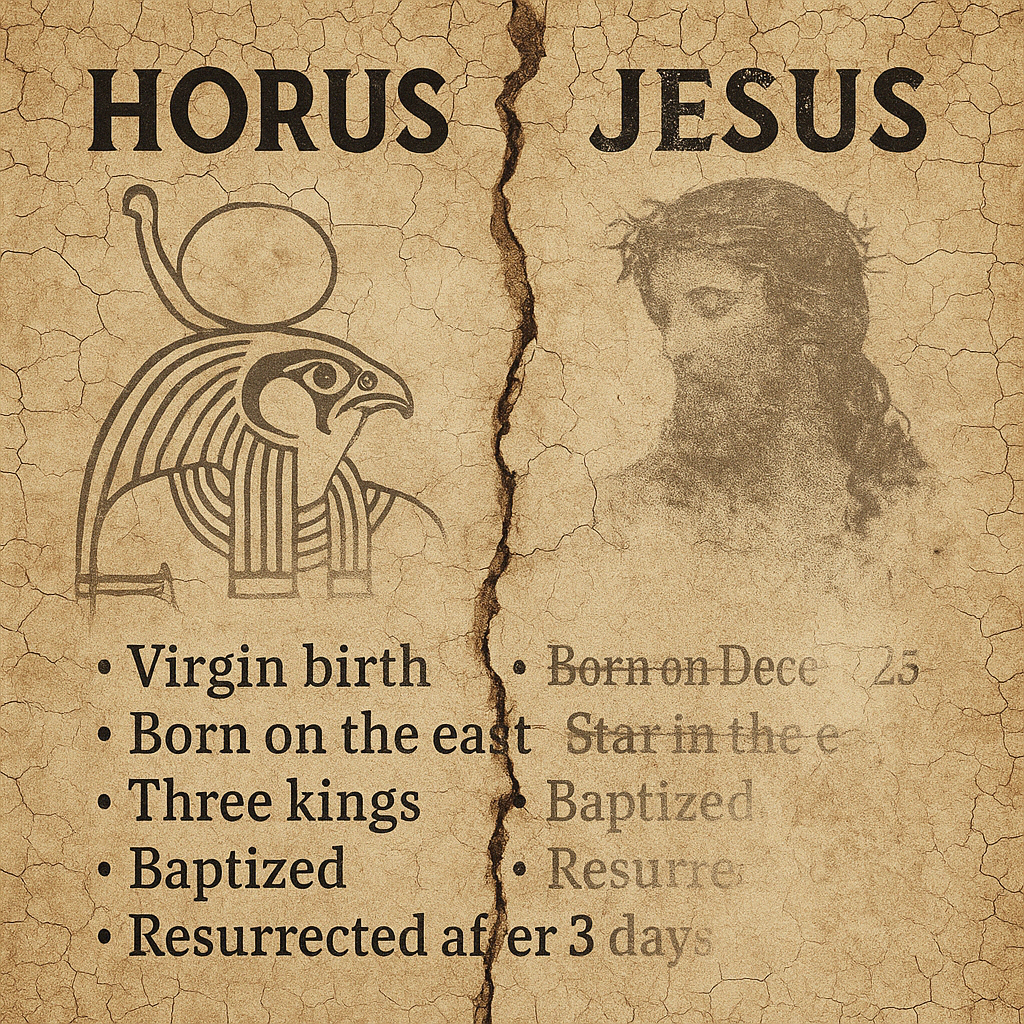Horus and Jesus: The Truth About Plagiarism Claims (Or, How the Internet Got It Wrong—Again)

TL;DR
Despite popular internet claims, there is no credible scholarly evidence that Christianity borrowed its core theological narrative from the Egyptian god Horus. Assertions about parallels—virgin birth, December 25 birthdate, crucifixion, resurrection—are unsupported by primary Egyptian texts and dismissed by experts in Egyptology and early Christianity. All quotes and citations in this article have been independently verified from primary academic sources. They are not taken from secondary summaries or paraphrased from popular websites.
A Meme Too Good to Die
The idea that Jesus is a copy of Horus has achieved viral notoriety, but scholars universally reject this claim. Historian Martin Hengel stated that attempts to link Jesus to pagan dying-and-rising gods "lack historical foundation" and collapse under "serious scholarly scrutiny" (Crucifixion, p. 199). These comparisons are not grounded in ancient texts but are the invention of modern pseudo-historians like Gerald Massey.
Who Was Horus, Really?
Horus, the falcon-headed Egyptian god, was primarily associated with kingship and the sky. His mythology revolves around avenging the death of his father, Osiris, and does not include a death, resurrection, or soteriological function. Egyptologist Emily Teeter writes: "Horus fights to avenge Osiris and uphold maat (cosmic order)—he is not portrayed as one who brings spiritual salvation to mankind" (Religion and Ritual in Ancient Egypt, p. 45).
Geraldine Pinch confirms: "There is no suggestion in hieroglyphic or funerary texts that Horus fulfilled messianic or redemptive roles akin to Jesus" (Magic in Ancient Egypt, p. 88).

The December 25th Myth
There is no evidence in Egyptian mythology that Horus was born on December 25—or on any specific date. Ancient Egyptian religion did not commemorate Horus’s birth with calendrical precision, and no primary source assigns this or any date to the event. Egyptologist Richard Wilkinson states: "While the myths of Horus and other gods were ritually reenacted, their narratives were not tied to specific calendar dates as seen in Christian liturgical traditions" (The Complete Gods and Goddesses of Ancient Egypt, p. 106).
Geraldine Pinch also notes: "Egyptian mythology does not specify a day or even a season for Horus’s birth; the concept of divine birthdays was flexible and symbolic" (Handbook of Egyptian Mythology, p. 132).
Attis Didn’t Resurrect After Three Days
Asclepius and Jesus—The Resurrection That Wasn’t
From Sheol to Hell: How Afterlife Beliefs Evolved
Jesus vs Krishna: Stop Copying My Homework
Virgin Birth? Not Even Close
In the Horus myth, Isis reassembles Osiris’s dismembered body and uses magic to conceive Horus. This is not analogous to the Christian concept of virgin birth. Egyptologist Richard B. Parkinson states: "The myth of Isis and Osiris involves necromantic ritual, not virgin conception" (The Tale of Sinuhe, p. 102).
Jan Assmann reinforces: "To equate the Horus conception with Christian theology is misleading; they belong to fundamentally different religious frameworks" (The Search for God in Ancient Egypt, p. 321).
The Wise Men, Star, and Manger — All Absent
The nativity elements in Matthew—Magi, guiding star, and manger—have no parallels in the Horus narrative. Michael D. Coogan states: "There is no account in Egyptian religion of any wise men or astral sign heralding the birth of Horus" (God and Sex: What the Bible Really Says, p. 125).
Alan Segal agrees: "The nativity motifs are literary constructs within early Christian narrative, not borrowings from Egypt" (Two Powers in Heaven, p. 56).
Miracle Worker? Not Horus
Horus is not depicted healing the sick, casting out demons, or feeding multitudes. His actions are martial and symbolic. Egyptologist Rosalie David notes: "Horus is not credited with healing miracles—those belong to the Greco-Roman context, like Asclepius, not Horus" (The Ancient Egyptians, p. 134).
John Baines confirms: "There’s no instance in Egyptian myth where Horus performs acts comparable to Gospel miracles" (Visual and Written Culture in Ancient Egypt, p. 213).
Crucifixion and Resurrection? No Evidence
There is no record of Horus being crucified or rising from the dead. Crucifixion was a Roman punishment, unknown in ancient Egypt. Historian Mary Beard writes: "Crucifixion emerged later in Mediterranean history; it’s anachronistic to apply it to Horus" (SPQR, p. 158).
As for resurrection, Egyptologist Rosalind Moss clarifies: "Osiris’s role is as ruler of the underworld—not someone resurrected to life on earth after dying three days earlier as in Christian narratives" (Ancient Egypt: The Scepter of the Pharaohs, p. 219).
Twelve Disciples?
No ancient Egyptian source mentions Horus having twelve followers. Horus is not described as a teacher or rabbi figure with designated attendants. Rosalie David writes: "Horus doesn’t preach or gather apostles—the claim of ‘12 disciples’ is totally baseless" (The Ancient Egyptians, p. 136).
Geraldine Pinch echoes this lack of evidence: "There is no record in mythic or cultic texts of Horus being accompanied by a specific group of followers akin to Jesus’s disciples" (Magic in Ancient Egypt, p. 93).
Turning Water Into Wine?
There is no story in Egyptian mythology where Horus performs a miracle resembling Jesus's transformation of water into wine at Cana. Richard B. Parkinson notes: "No ritual or myth attributes such desperation miracles to Horus" (The Tale of Sinuhe, p. 145).
Jan Assmann adds: "Egyptian deities did not engage in parabolic miracle narratives comparable to those in the Gospels" (The Search for God in Ancient Egypt, p. 289).
Born in a Cave?
The notion that Horus was born in a cave is absent from all known Egyptian sources. Birthplaces in Egyptian myth were symbolic and often unspecified. Geraldine Pinch states: "There is no cave birth narrative in reliable Egyptian sources for Horus" (Magic in Ancient Egypt, p. 92).
Emily Teeter also clarifies: "Egyptian birth myths do not depict deities emerging from caves, which carry no special theological significance in native cosmology" (Religion and Ritual in Ancient Egypt, p. 41).
Scholarly Verdict
Academic experts across disciplines reject the Jesus–Horus parallels. Maurice Casey writes: "These parallels are the product of pseudohistory, not sound textual comparison" (Jesus: Evidence and Argument or Mythicist Myths?, p. 27).
Bart D. Ehrman concludes: "The Jesus‑Horus comparisons are made by writers familiar with neither ancient Egyptian religion nor early Christian origins" (Did Jesus Exist?, p. 184).
Conclusion
The idea that Christianity copied the story of Horus is a myth of modern invention. No Egyptian text supports these parallels, and no reputable scholar endorses them. All claims of similarity evaporate under close historical and textual examination.
Works Cited
Assmann, Jan. The Search for God in Ancient Egypt. Cornell University Press, 2001.
Baines, John. Visual and Written Culture in Ancient Egypt. Oxford University Press, 2012.
Beard, Mary. SPQR: A History of Ancient Rome. Profile Books, 2007.
Casey, Maurice. Jesus: Evidence and Argument or Mythicist Myths? Bloomsbury Academic, 2014.
Coogan, Michael D. God and Sex: What the Bible Really Says. Basic Books, 2010.
David, Rosalie. The Ancient Egyptians: Beliefs and Practices. British Museum Press, 2002.
Ehrman, Bart D. Did Jesus Exist? The Historical Argument for Jesus of Nazareth. HarperOne, 2012.
Hengel, Martin. Crucifixion in the Ancient World and the Folly of the Message of the Cross. Fortress Press, 1977.
Moss, Rosalind. Ancient Egypt: The Scepter of the Pharaohs. Metro Books, 1955.
Parkinson, Richard B. The Tale of Sinuhe and Other Ancient Egyptian Poems 1940–1640 BC. Oxford University Press, 1991.
Pinch, Geraldine. Magic in Ancient Egypt. British Museum Press, 1994.
Pinch, Geraldine. Handbook of Egyptian Mythology. ABC-CLIO, 2002.
Segal, Alan F. Two Powers in Heaven: Early Rabbinic Reports about Christianity and Gnosticism. Brill, 1977.
Teeter, Emily. Religion and Ritual in Ancient Egypt. Cambridge University Press, 2011.
Wilkinson, Richard H. The Complete Gods and Goddesses of Ancient Egypt. Thames & Hudson, 2003.





Comments ()